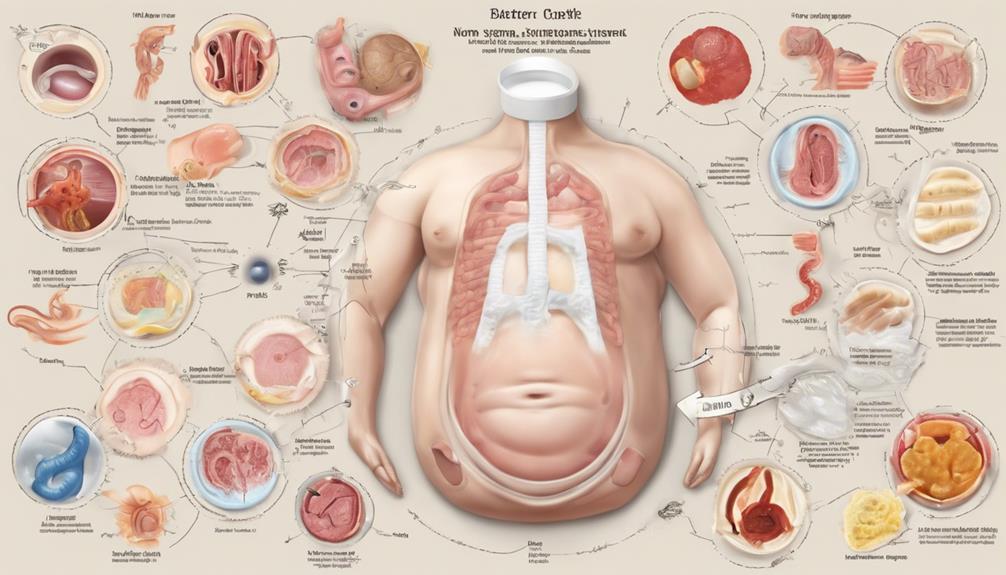Explore the intricacies of formula feeding for new parents, like piecing together a puzzle. Are you interested in learning more about the specific elements involved in providing the best nutrition for your baby?
Well, in this guide, we will unravel the secrets behind proper formula preparation and feeding techniques that are essential for your baby's well-being. Stay tuned as we uncover the essential tips and tricks to navigate the world of formula feeding with ease and confidence.
Key Takeaways
- Choose appropriate formula type for baby's needs
- Ensure correct water-to-formula ratio for nutrition
- Invest in quality bottles and nipples for feeding comfort
- Follow safety guidelines for proper formula preparation
Formula Feeding Basics
When starting formula feeding, it's essential to understand the fundamental principles that form the basis of this feeding method. Formula, specially designed to provide essential nutrients for babies, comes in various types such as powdered, liquid, and ready-to-use formulas. Each type offers convenience based on individual preferences and needs. Proper preparation of formula is important for the baby's health. It's important to use the right proportion of water and formula to make sure the baby receives adequate nutrition. Additionally, correct storage of prepared formula is necessary to prevent bacterial contamination and spoilage.
Feeding a baby with a bottle allows both parents to actively participate in caring for and bonding with their little one, fostering a sense of shared responsibility. Seeking guidance from healthcare professionals can address any concerns or questions about formula feeding, making sure that parents feel confident and supported in providing the best nutrition for their baby.
Essential Equipment for Formula Feeding

To make sure a smooth and comfortable feeding experience for your baby, selecting the right bottles and nipples is essential. When it comes to essential equipment for formula feeding, here are some key points to think about:
- Choose bottles with nipples that mimic breastfeeding: This choice can help with a better latch and feeding experience for your little one.
- Opt for bottles with appropriate flow rates: Select nipples that match your baby's age and feeding preferences to make sure they're getting the right amount of formula at each feeding.
- Look for bottles that are easy to clean: Maintaining hygiene is important, so opt for bottles that are easy to clean and sterilize after each use.
Tips for Making Formula Feeding Easier
Investing in a formula pitcher can greatly simplify the mixing and storage process, making formula feeding more convenient for new parents. A formula pitcher allows you to prepare multiple bottles at once, saving time during those hectic feeding moments. For even more convenience, consider using a Baby Brezza Formula Pro Advanced, which automates formula preparation with the push of a button, guaranteeing the perfect temperature and consistency every time.
When it comes to bottle feeding, pay close attention to the nipple flow rates. Using the correct flow rate for your baby's age guarantees they can feed comfortably without getting overwhelmed or frustrated. Additionally, avoid heating formula in the microwave as it can lead to uneven heating and hot spots, potentially burning your baby's mouth.
To end, maintain good water quality for formula preparation. Using clean, safe water is essential for your baby's health, so be sure to follow guidelines for water quality when mixing formula. By incorporating these tips into your feeding schedule, you can make formula feeding a smoother and more enjoyable experience for both you and your little one.
Understanding Formula Types

For new parents exploring the world of formula feeding, one key aspect to grasp is the understanding of different formula types available in the market. When choosing the right formula for your baby, it's crucial to take into account their specific needs and any potential allergies or intolerances they may have. Here are some key points to bear in mind:
- Milk-based Formula: A common choice in the U.S., milk-based formulas are usually iron-fortified to provide essential nutrients for your baby's growth and development.
- Soy-based Formula: An alternative for infants with milk allergies or intolerances, soy-based formulas can be a suitable option for babies who can't consume dairy products.
- Specialized Formulas: These cater to unique cases such as premature infants or babies with metabolic disorders, ensuring they receive proper nutrition tailored to their specific requirements.
Safety Measures for Formula Feeding
Implementing safety measures during formula feeding is important to safeguard your baby's health and well-being. Babies have weakened immune systems, making it essential to take extra precautions. Here are some essential safety tips to make sure your baby's formula feeding experience is as safe as possible:
| Safety Measures | Tips |
|---|---|
| Use bottled water | Babies need fresh tap water boiled for 30 minutes for safe formula preparation. |
| Feed Infant Formula at room temperature | Make sure the formula is body temperature to prevent burning your baby's mouth. |
| Dispose of unused formula within two hours | Do not leave formula out for too long to avoid bacterial growth. |
| Test the temperature | Always test the formula on your wrist first to prevent feeding your baby hot formula. |
Frequently Asked Questions
How Much Should I Feed My Baby When Supplementing With Formula?
When supplementing with formula, we should feed our baby based on hunger cues, starting with 1-3 ounces per feeding. Generally, babies consume around 2.5 ounces of formula per pound of body weight per day, adjusted as needed.
How Much Formula Should I Give for the First Time?
We usually start with 1-2 ounces of formula for the first feed. It helps gauge the baby's appetite. Watching for cues like turning away or slowing down during feeding can guide how much they need.
How Much Formula Should a Newborn Eat Chart?
When determining how much formula a newborn should eat, consider their age, weight, and hunger cues. On average, newborns consume 1-3 ounces per feeding, gradually increasing to 2-4 ounces. Monitoring weight gain and consulting healthcare providers is important for proper nutrition.
How Long Does It Take for Baby to Adjust to Formula Change?
It usually takes babies 3-5 days to adjust to a new formula, though some may adapt faster within 1-2 days. Mixing old and new formula gradually can help. Look for signs of tolerance like reduced fussiness.
Conclusion
To sum up, remember that when it comes to formula feeding, preparation is key. As the saying goes, 'an ounce of prevention is worth a pound of cure.'
By following the tips and guidelines in this ultimate formula feeding guide, you can make sure that your baby is getting the nutrition they need to thrive. Trust your instincts, stay informed, and don't hesitate to reach out for support when needed.
Your baby's health and well-being are worth every effort.










